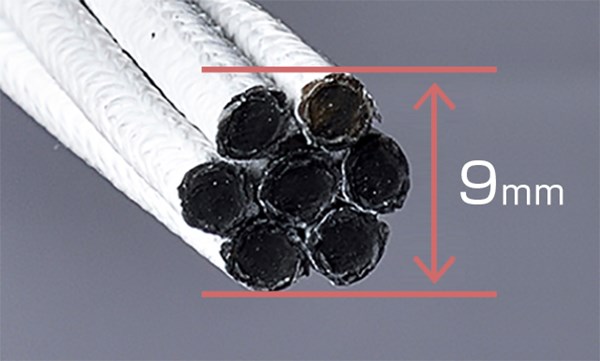Carbon fiber performs aesthetically and structurally
From the informative website called Composites and Architecture, hosted by Kreysler and Associates (American Canyon, CA, US), comes a unique use of carbon fiber strands.

Komatsu Seiren's building in Japan with carbon fiber strands as seismic reinforcement.
For readers who don’t know, there’s a highly interesting and informative website called Composites and Architecture, hosted by Kreysler and Associates (American Canyon, CA, US). If you don’t know Kreysler and Associates, you should — they are a leader in getting composite materials into construction and architectural applications, and we’ve written about their projects on many occasions (here’s two articles: http://www.compositesworld.com/articles/sfmoma-faade-advancing-the-art-of-high-rise-frp; http://www.compositesworld.com/articles/residential-construction-breakthrough-composites-find-a-home).
The aforementioned web site is an eclectic assortment of composites’ use in exteriors, interiors, furniture, sculpture, and new material technology. A recent post involves Japanese textile manufacturer Komatsu Seiren (Ishikawa, Japan), a maker of a variety of fabrics, including some advanced materials. They recently undertook the renovation of their former head office building, with the goal of creating exhibition, museum, office and laboratory spaces, including a rooftop terrace. Project architect Kengo Kuma, interviewed in a video on the Komatsu Seiren web site, wanted to show both the high strength and the lightness and delicacy of carbon fiber strands, using Komatsu Seiren’s own Cabkoma strand rod, developed and manufactured at the facility starting in 2010.
Cabkoma comprises carbon fiber tow that is encapsulated by a sheath of glass or aramid fiber, wet out with a thermoplastic matrix. Seven coated tows are bundled and twisted together to form a single flexible rod, white in color. The company claims the tensile strength of a 5.83mm diameter rod is 38.22 kN (8,592 lbs), or 1.43 kN/mm2 (207,350 psi). The rods are considerably smaller in diameter, and lighter in weight, than steel reinforcement of equal strength; a 160-meter coil of the rod weighs just 12 kg (26.5 lbs). For the rehab and seismic project, the rods were inserted and adhesively bonded into end fittings called rod bearing jigs for attachment to a rooftop anchor structure and into the ground, around the exterior perimeter of the building. They were also used to bolster seismic resistance within the interior, notably, forming lattice shear walls between building columns, with rods oriented at 45° angles.

Closeup of the Cabkoma rod product, from the Komatsu Seiren web site.
In effect, the building's exterior has been “wrapped” by hundreds of spaced Cabkoma rods or strands, that almost resemble a sheer undulating fabric. The result is an airy, organic façade that has a fabric-like aesthetic (true to the building’s purpose) while still offering the strength to resist ground motion during an earthquake event.
Kuma says in the video that the project was a challenge, solvable only with today’s computers, to determine how many rods were necessary and how to best accomplish the seismic reinforcement needed (in addition to conventional earthquake reinforcement installed in the building as required by Japanese building code). He believes the rod will “change things” and has the potential to create a major revolution in the world of construction.
Watch the video interview with Kengo Kuma about the building reinforced with Cabkoma strands. Kuma is a well-known Japanese architect and professor at the Graduate School of Architecture at the University of Tokyo: http://www.komatsuseiren.co.jp/cabkoma/en/index.html.
Related Content
Novel dry tape for liquid molded composites
MTorres seeks to enable next-gen aircraft and open new markets for composites with low-cost, high-permeability tapes and versatile, high-speed production lines.
Read MoreThe state of recycled carbon fiber
As the need for carbon fiber rises, can recycling fill the gap?
Read MoreOne-piece, one-shot, 17-meter wing spar for high-rate aircraft manufacture
GKN Aerospace has spent the last five years developing materials strategies and resin transfer molding (RTM) for an aircraft trailing edge wing spar for the Airbus Wing of Tomorrow program.
Read MoreMaterials & Processes: Fibers for composites
The structural properties of composite materials are derived primarily from the fiber reinforcement. Fiber types, their manufacture, their uses and the end-market applications in which they find most use are described.
Read MoreRead Next
Composites end markets: Energy (2024)
Composites are used widely in oil/gas, wind and other renewable energy applications. Despite market challenges, growth potential and innovation for composites continue.
Read MoreCW’s 2024 Top Shops survey offers new approach to benchmarking
Respondents that complete the survey by April 30, 2024, have the chance to be recognized as an honoree.
Read MoreFrom the CW Archives: The tale of the thermoplastic cryotank
In 2006, guest columnist Bob Hartunian related the story of his efforts two decades prior, while at McDonnell Douglas, to develop a thermoplastic composite crytank for hydrogen storage. He learned a lot of lessons.
Read More

























